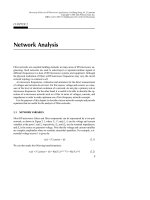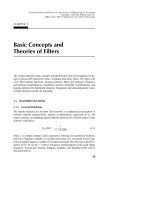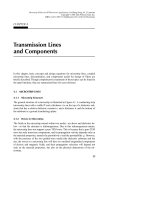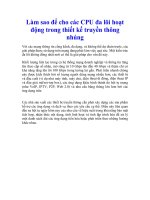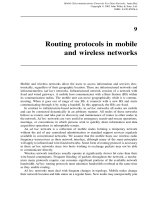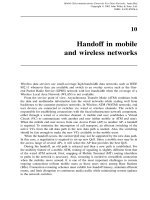Tài liệu Microstrip bộ lọc cho các ứng dụng lò vi sóng RF (P9) doc
Bạn đang xem bản rút gọn của tài liệu. Xem và tải ngay bản đầy đủ của tài liệu tại đây (884.27 KB, 42 trang )
CHAPTER 9
CAD for Low-Cost and
High-Volume Production
There have been extraordinary recent advances in computer-aided design (CAD) of
RF/microwave circuits, particularly in full-wave electromagnetic (EM) simulations.
They have been implemented both in commercial and specific in-house software
and are being applied to microwave filter simulation, modeling, design, and valida-
tion [1]. The developments in this area are certainly stimulated by increasing com-
puter power. In the past decade, computer speed and memory have doubled about
every 2 years [2]. If we accept the idea that this trend can continue, it is not hard to
imagine how this increased capability will be used.
Another driving force for the developments is the requirement of CAD for low-
cost and high-volume production [3–4]. In general, besides the investment for tool-
ing, the cost of filter production is mainly affected by materials and labor. Microstrip
filters using conventional printed circuit boards are of low cost in themselves. Using
better materials such as superconductors can give better performance of filters, but is
normally more expensive. This may then be evaluated by a cost-effective factor in
terms of the performance. Labor costs include those for design, fabrication, testing,
and tuning. Here the weights for the design and tuning can be reduced greatly by us-
ing CAD. For instance, in addition to controlling fabrication processes, to tune or not
to tune is also much the question of design accuracy, and tuning can be very expen-
sive and time costuming for mass production. CAD can provide more accurate design
with less design iterations, leading to first-pass or tuneless filters. This not only re-
duces the labor intensiveness and so the cost, but also shortens the time from design
to production. The latter can be crucial for wining a market in which there is severe
competition. Furthermore, if the materials used are expensive, the first-pass design or
less iteration afforded by CAD will reduce the extra cost of the materials and other
factors necessary for developing a satisfactory prototype.
Generally speaking, any design that involves using computers may be termed as
CAD. This may include computer simulation and/or computer optimization. The in-
273
Microstrip Filters for RF/Microwave Applications. Jia-Sheng Hong, M. J. Lancaster
Copyright © 2001 John Wiley & Sons, Inc.
ISBNs: 0-471-38877-7 (Hardback); 0-471-22161-9 (Electronic)
tention of this chapter is to discuss some basic concepts, methods, and issues re-
garding filter design by CAD. Typical examples of the applications will be de-
scribed. As a matter of fact, many more CAD examples, in particular those based on
full-wave EM simulation, can be found for many filter designs described in the oth-
er chapters of this book.
9.1 COMPUTER-AIDED DESIGN TOOLS
CAD tools can be developed in-house for particular applications. They can be as
simple as a few equations written using any common math software such as Math-
cad [5]. For example, the formulations for network connections provided in Chapter
2 can be programmed in this way for analyzing numerous filter networks. There is
also now a large range of commercially available RF/microwave CAD tools that are
more sophistical and powerful, and might include a linear circuit simulator, analyti-
cal modes in a vendor library, a 2D or 3D EM solver, and optimizers. Some vendors
with their key products for RF/microwave filter CAD are listed in Table 9.1.
9.2 COMPUTER-AIDED ANALYSIS
9.2.1 Circuit Analysis
Since most filters are comprised of linear elements or components, linear simula-
tions based on the network or circuit analyses described in Chapter 2 are simple and
274
CAD FOR LOW-COST AND HIGH-VOLUME PRODUCTION
TABLE 9.1 Some commercially available CAD tools
Company Product (all trademarks) Type
HP-EEsof ADS Integrated package
Momentum 3D planar EM simulation
HFSS 3D EM simulator
Sonnet Software em 3D planar EM simulation
xgeom Layout entry
emvu Current display
Applied Wave Research (AWR) Microwave Office Integrated package
(including a linear simulator, 3D
planar EM simulator, optimizers)
Ansoft Ansoft HFSS 3D EM simulation
Ensemble Planar EM simulator
Harmonica Linear and nonlinear simulation
Zeland Software IE3D Planar and 3D EM simulation and
Optimization package
Jansen Microwave Unisym/Sfpmic 3D planar EM simulation
QWED s.c. QuickWave–3D 3D EM simulation
fast for computer-aided analysis (CAA). Linear simulations analyze frequency re-
sponses of microwave filters or elements based on their analytical circuit models.
Analytical models are fast. However, they are normally only valid in certain ranges
of frequency and physical parameters.
To demonstrate how a linear simulator usually analyzes a filter, let us consider a
stepped-impedance, microstrip lowpass filter shown in Figure 9.1(a), where W
0
de-
notes the terminal line width; W
1
and l
1
are the width and length of the inductive line
element; and W
2
and l
2
are the width and length of the capacitive line element. For the
linear simulation, the microstrip filter structure is subdivided into cascaded elements
and represented by a cascaded, network as illustrated in Figure 9.1(b). We note that in
addition to the three line elements, four step discontinuities along the filter structure
9.2 COMPUTER-AIDED ANALYSIS
275
FIGURE 9.1 (a) Stepped-impedance microstrip lowpass filter. (b) Its network representation with cas-
caded subnetworks for network analysis. (c) Equivalent circuits for the subnetworks.
(c)
(b)
(a)
have been taken into account. Each of the subnetworks is described by the corre-
sponding equivalent circuit shown in Figure 9.1(c). The analytical models or closed-
form expressions, such as those given in Chapter 4, are used to compute the circuit
parameters, i.e., L
1
, L
2
and C for the microstrip step discontinuities, the characteristic
impedance Z
c
, and the propagation constant

for the microstrip line elements. The
ABCD parameters of each subnetwork can be determined by the formulations given
in Figure 2.2 of Chapter 2. The ABCD matrix of the composite network of Figure
9.1(b) is then computed by multiplying the ABCD matrices of the cascaded subnet-
works, and can be converted into the S matrix according to the network analysis dis-
cussed in Chapter 2. In this way, the frequency responses of the filter are analyzed.
For a numerical demonstration, recall the filter design given in Figure 5.2(a) of
Chapter 5. We have all the physical dimensions for analyzing the filter, as follows: W
0
= 1.1 mm, W
1
= 0.2 mm, l
1
= 9.81 mm, W
2
= 4.0 mm, and l
2
= 7.11 mm on a 1.27 mm
thick substrate with a relative dielectric constant
r
= 10.8. Using the closed-form ex-
pressions given in Chapter 4, we can find the circuit parameters of the subnetworks
in Figure 9.1, which are listed in Table 9.2, where f is the frequency in GHz.
The ABCD matrix for each of the line subnetworks (lossless) is
΄΅
(9.1)
For each of the step subnetworks, the ABCD matrix is given by
΄΅
(9.2)
The ABCD matrix of the whole filter network is computed by
΄΅
=
⌸
i=1
΄΅
i
(9.3)
where i denotes the number of the subnetworks as consecutively listed in Table 9.2,
and the ABCD matrices on the right-hand side for the subnetworks are given by ei-
B
D
A
C
B
D
A
C
(j
L
1
+ j
L
2
) – j
3
CL
1
L
2
1 –
2
CL
2
1 –
2
CL
1
j
C
jZ
c
sin

l
cos

l
cos

l
j sin

l/Z
c
276
CAD FOR LOW-COST AND HIGH-VOLUME PRODUCTION
TABLE 9.2 Circuit parameters of the filter in Figure 9.1
Subnetwork Circuit parameters
_______________ _________________________________________________________________
No. Name Z
c
(ohm)

(rad/mm) l (mm) L
1
(nH) L
2
(nH) C (pF)
1 Step 1 0.085 0.151 0.056
2 Line 1 93 0.05340 f 9.81
3 Step 2 0.493 0.142 0.087
4 Line 2 24 0.05961 f 7.11
5 Step 3 0.142 0.493 0.087
6 Line 3 93 0.05340 f 9.81
7 Step 4 0.151 0.085 0.056
ther (9.1) for the line subnetworks or (9.2) for the step subnetworks. The transmis-
sion coefficient of the filter is computed by
S
21
= (9.4)
where the terminal impedance Z
0
= 50 ohms. Figure 9.2 shows the linear simula-
tions of the filter as compared with the EM simulation obtained previously in Fig-
ure 5.2(b). Note that the broken line represents the linear simulation that takes all
the discontinuities into account, whereas the dotted line is for the linear simulation
ignoring all the discontinuities. As can be seen, the former agrees better with the
EM simulation.
Another useful example is shown in Figure 9.3(a). This is a three-pole microstrip
bandpass filter using parallel-coupled, half-wavelength resonators, as discussed in
Chapter 5. For simplicity, we assume here that all the coupled lines have the same
width W. The filter is subdivided into cascaded subnetworks, as depicted in Figure
9.3(b), for linear simulation. The computation of the ABCD matrices for the step
subnetworks is similar to that discussed above. The ABCD parameters for each of
the coupled-line subnetworks may be computed by [6]
A = D =
B = (9.5)
C =
2j
ᎏᎏᎏ
Z
0e
csc
e
– Z
0o
csc
o
Z
2
0e
+ Z
2
0o
– 2Z
0e
Z
0o
(cot
e
cot
o
+ csc
e
csc
o
)
ᎏᎏᎏᎏᎏ
Z
0e
csc
e
– Z
0o
csc
o
j
ᎏ
2
Z
0e
cot
e
+ Z
0o
cot
o
ᎏᎏᎏ
Z
0e
csc
e
– Z
0o
csc
o
2
ᎏᎏᎏ
A + B/Z
0
+ CZ
0
+ D
9.2 COMPUTER-AIDED ANALYSIS
277
FIGURE 9.2 Computer simulated frequency responses of a microstrip lowpass filter.
where Z
0e
and Z
0o
are the even-mode and odd-mode characteristic impedances,
e
and
o
are the electrical lengths of the two modes, as discussed in Chapter 4. Nu-
merically, consider a microstrip filter of the form in Figure 9.3(a) having the dimen-
sions: W
0
= 1.85 mm, W = 1.0 mm, s
1
= s
4
= 0.2 mm, l
1
= l
4
= 23.7 mm, s
2
= s
3
=
0.86 mm, and l
2
= l
3
= 23.7 mm on a GML1000 dielectric substrate with a relative
dielectric constant
r
= 3.2 and a thickness h = 0.762 mm. It is important to note that
the effect due to the open end of the lines must be taken into account when
e
and
o
are computed [7]. This can be done by increasing the line length such that l
Ǟ
l +
⌬l, where ⌬l may be approximated by the single line open end described in Chapter
4, or more accurately by the even- and odd-mode open-end analysis as described in
[8]. Figure 9.4 plots the frequency responses of the filter as analyzed.
It should be mentioned that in addition to the errors in analytical models, partic-
ularly when the various elements that make up a microstrip filter are packed tightly
together, there are several extra potential sources of errors in the analysis. Circuit
simulators assume that discontinues are isolated elements fed by single-mode mi-
crostrip lines. But there can be electromagnetic coupling between various of the net-
work due to induced voltages and currents. It takes time and distance to reestablish
the normal microstrip current distribution after it passes through a discontinuity. If
another discontinuity is encountered before the normal current distribution is
reestablished, the “initial conditions” for the second discontinuity are now different
from the isolated case because of the interaction of higher modes whose effects are
not negligible any more. All these potential interactions suggest caution whenever
we subdivide a filter structure for either circuit analysis or EM simulation.
278
CAD FOR LOW-COST AND HIGH-VOLUME PRODUCTION
l
1
l
2
l
3
W
W
0
s
1
s
2
s
3
s
4
l
4
(b)
(a)
FIGURE 9.3 (a) Microstrip bandpass filter. (b) Its network representation with cascaded subnetworks
for network analysis.
9.2.2 Electromagnetic Simulation
Electromagnetic (EM) simulation solves the Maxwell equations with the boundary
conditions imposed upon the RF/microwave structure to be modeled. Most com-
mercially available EM simulators use numerical methods to obtain the solution.
These numerical techniques include the method of moments (MoM) [9–10], the fi-
nite-element method (FEM) [11], the finite-difference time-domain method
(FDTD) [12], and the integral equation (boundary element) method (IE/BEM)
[13–14]. Each of these methods has its own advantages and disadvantages and is
suitable for a class of problems [15–18]. It is not our intention here to present these
methods, and the interested reader may refer to the references for the details. How-
ever, we will concentrate on the appropriate utilization of the EM simulations.
EM simulation tools can accurately model a wide range of RF/microwave struc-
tures and can be more efficiently used if the user is aware of sources of error. One
principle error, which is common to most all the numerical methods, is due to the fi-
nite cell or mesh sizes. These EM simulators divide a RF/microwave filter structure
into subsections or cells with 2D or 3D meshing, and then solve Maxwell’s equa-
tions upon these cells. Larger cells yields faster simulations, but at the expense of
larger errors. Errors are diminished by using smaller cells, but at the cost of longer
simulation times. It is important to learn if the errors in the filter simulation are due
to mesh-size errors. This can be done by repeating the EM simulation using differ-
ent mesh sizes and comparing the results, which is known as a convergence analysis
[19–20].
For demonstration, consider a microstrip pseudointerdigital bandpass filter [19]
shown in Figure 9.5. The filter is designed to have 500 MHz bandwidth at a cen-
ter frequency of 2.0 GHz and is composed of three identical pairs of pseudointer-
digital resonators. The development of this type of filter is detailed in Chapter 11.
9.2 COMPUTER-AIDED ANALYSIS
279
FIGURE 9.4 Computer simulated frequency responses of a microstrip bandpass filter.
All pseudointerdigital lines have the same width—0.5 mm. The coupling spacing
s
1
= s
2
= 0.5 mm for each pair of the pseudointerdigital resonators. The coupling
spacing between contiguous pairs of the pseudointerdigital resonators is denoted
by s, and in this case s = 0.6 mm. Two feeding lines, which are matched to the 50
ohm input/output ports, are 15 mm long and 0.2 mm wide. The feeding lines are
coupled to the pseudointerdigital structure through 0.2 mm separations. The whole
size of the filter is 15 mm by 12.5 mm on a RT/Duriod substrate having a thick-
ness of 1.27 mm and a relative dielectric constant of 10.8. This size is about
g
/4
by
g
/4, where
g
is the guided wavelength at the midband frequency on the sub-
strate. For this type of compact filter, the cross coupling of all resonators would be
expected. Therefore, it is necessary to use EM simulation to achieve more accurate
analysis.
This filter was simulated using a 2.5D (or 3D-planar) EM simulator em [21],
but other analogous products could also have been utilized. Similar to most EM
simulators, one of the main characteristics of the EM simulator used is the simu-
lation grid or mesh, which can be defined by the user and is imposed on the ana-
lyzed structure during numerical EM analysis. Like any other numerical technique
based on full-wave EM simulators, there is a convergence issue for the EM simu-
lator used. That is, the accuracy of the simulated results depends on the fineness
of the grid. Generally speaking, the finer the grid (smaller the cell size), the more
accurate the simulation results, but the longer the simulation time and the larger
the computer memory required. Therefore, it is very important to consider how
small a grid or cell size is needed for obtaining accurate solutions from the EM
simulator. To determine a suitable cell size, Figure 9.6 shows the simulated filter
frequency responses, i.e., the transmission loss and the return loss for different cell
280
CAD FOR LOW-COST AND HIGH-VOLUME PRODUCTION
15 mm
12.5mm
0.2mm
0.5 mm
0.6mm
0.6mm
0.2mm
g
0.5mm
s
1
s
1
s
2
s
s
FIGURE 9.5 Layout of a microstrip pseudointerdigital bandpass filter for EM simulation. The filter is
on a 1.27 mm thick substrate with a relative dielectric constant of 10.8.
sizes. As can be seen, when the cell size is 0.5 mm by 0.25 mm, the simulation re-
sults (full lines) are far from the convergence and give a wrong prediction.
However, as the cell size becomes smaller, the simulation results are approaching
the convergent ones and show no significant changes when the cell size is further
reduced below the cell size of 0.25 mm by 0.1 mm, since the curves for the cell
size of 0.5 mm by 0.1 mm almost overlap those for the cell size of 0.25 mm by
9.2 COMPUTER-AIDED ANALYSIS
281
FIGURE 9.6 Convergence analysis for EM simulations of the filter in Figure 9.5.
(b)
(a)
0.1 mm. This cell size, in terms of
g
, is about 0.0045
g
by 0.0018
g
. The com-
putational time and the required computer memory for the different cell sizes are
the other story. Using a SPARC–2 computer a computing time of 29 seconds
per frequency and 1 Mbyte/385 subsections are needed when the cell size is 0.5
mm by 0.25 mm. Note that the EM uses the rectangular grid or cell and consoli-
dates groups of cells into larger “subsections” in regions where high cell density
is not needed. In any case, the smaller cell size results in a larger number of the
subsections. Using the same computer, the computing times are 47, 238, and 675
seconds per frequency, and the required computer memories are 1 Mbyte/482 sub-
sections, 4 Mbyte/920 subsections, and 7 Mbyte/1298 subsections for the cell
sizes of 0.5 mm by 0.2 mm, 0.5 mm by 0.1 mm, and 0.25 mm by 0.1 mm , re-
spectively. As can be seen, both the computational time and computer memory in-
crease very fast as the cell size becomes smaller. To make the EM simulation not
only accurate but also efficient, using a cell size of 0.5 mm by 0.1 mm should be
adequate in this case. It should be noticed that how small a cell size, which is
measured in physical units (say mm) by the EM simulator, should be specified for
convergence is also dependent on operation frequency. In general, the lower the
frequency, the larger is the cell size that would be adequate for the convergence.
For this reason, it would not be wise to specify a very wide operation frequency
range (say 1 to 10 GHz) at once for simulation because it would require a very
fine grid or small cell in order to obtain a convergent simulation at the highest fre-
quency, and such a fine grid would be more than adequate for the convergence at
the lower frequency band, so that a large unnecessary computation time would re-
sult.
To verify the accuracy of the electromagnetic analysis, the simulated results us-
ing a cell size of 0.5 mm by 0.1 mm are plotted in Figure 9.7 together with the mea-
sured results for comparison. Good agreement, except for some frequency shift be-
tween the measured and the simulated results, can be observed. The frequency shift
between the measured and simulated responses is most likely due to the tolerances
in the fabrication and substrate material and/or to the assumption of zero metal strip
thickness by the EM simulator used [19].
In many practical computer-aided designs, to speed up a filter design, EM simu-
lation is used to accurately model individual components that are implemented in a
filter. The initial design is then entirely based on these circuit models, and the simu-
lation of the whole filter structure may be performed as a final check [22–26]. In
fact, we have applied this approach to many filter designs described in Chapters 5
and 6. We will demonstrate more in the rest of this book. This CAD technique
works well in many cases, but caution should be taken when breaking the filter
structure into several parts for the EM simulation. This is because, as mentioned
earlier, the interface conditions at a joint of any two separately simulated parts can
be different from that when they are simulated together in the larger structure. Also,
when we use this technique, we assume that the separated parts are isolated ele-
ments, but in the real filter structure they may be coupled to one another; these un-
wanted couplings may have significant effects on the entire filter performance, es-
pecially in microstrip filters [27].
282
CAD FOR LOW-COST AND HIGH-VOLUME PRODUCTION
9.2.3 Artificial Neural Network Modeling
Artificial neural network (ANN) modeling has emerged as a powerful CAD tool re-
cently [28–35]. In general, ANNs are computational tools that mimic brain func-
tions, such as learning from experience (training), generalizing from previous ex-
amples to new ones, and abstracting characteristics from inputs. For CAD of filters,
9.2 COMPUTER-AIDED ANALYSIS
283
(b)
(a)
FIGURE 9.7 Comparison of the EM simulated and measured performances of the filter in Figure 9.5.
The simulation uses a cell size of 0.5 × 0.1 mm.
ANNs are used to model filters or filter components to nearly same degree of accu-
racy as that afforded by EM simulation, but with less computation effort once they
are trained.
ANN models can be trained by experiments and/or full-wave EM simulators.
The latter lead to an efficient usage of EM simulation for CAD. In this methodolo-
gy, EM simulation is used to obtain S parameters for all the components to be mod-
eled over the ranges of designable parameters and frequencies for which these mod-
els are expected to be used. Figure 9.8(a) depicts a block diagram for such an ANN
model. An ANN model for each one of the components is developed by training an
ANN configuration based on a particular ANN architecture using the data from EM
simulations. Figure 9.8(b) illustrates a typical ANN architecture, consisting of an
input layer, an output layer, and one hidden layer with layers of computing nodes
termed neurons. Each neuron forms a weighted (w or v) sum of its inputs, which is
284
CAD FOR LOW-COST AND HIGH-VOLUME PRODUCTION
FIGURE 9.8 (a) Block diagram of an ANN model. (b) Typical ANN architecture.
(b)
(a)
passed through a nonlinear activation function (F or G). Such an ANN allows mod-
eling of complex input–output relationships between multiple inputs {x
1
, x
2
··· x
l
}
and multiple outputs {y
1
, y
2
··· y
K
}. For the given activation function of each neu-
ron, a set of the weights is called a configuration. Training an ANN model is ac-
complished by adjusting these weights to give the desired responses via a learning
or optimizing algorithm. Such ANN models, which retain the accuracy obtainable
from EM simulators once trained and at the same time exhibit the efficiency (in
terms of computer time required) that is obtained from analytical circuit models, are
then used for CAD.
It would seem that ANN models are similar to the numerical models obtained by
curve-fitting techniques. A primary advantage of ANNs over the curve-fitting tech-
niques is that the ANNs have more advanced architectures and more general func-
tional forms. The class of neural network and/or architecture selected for a particu-
lar model implementation will be dependent on the problem to be solved.
9.3 OPTIMIZATION
For design optimization of filters, one often starts with a given set of filter specifi-
cations and an initial filter design. The computer-aided analysis techniques outlined
in the previous section are used to evaluate filter performance. Filter characteristics
obtained from the analysis are compared with the given specifications. If the results
fail to satisfy the desired specifications, the designable (optimization) parameters of
the filter are altered in a systematic manner. The sequence of filter analysis, com-
parison with the desired performance, and modification of designable parameters is
performed iteratively until the optimum performance of the filter is achieved. This
process is known as optimization [36–38]. Some basic concepts and methods of op-
timization will be presented in the following sections.
9.3.1 Basic Concepts
The problem of optimization may be formulated as minimization of a scalar objec-
tive function U(⌽), where U(⌽) is also known as an error function or cost function
because it represents the difference between the performance achieved at any stage
and the desired specifications. For example, in the case of a microwave filter, the
formulation of U(⌽) may involve the specified and achieved values of the insertion
loss and the return loss in the passband, and the rejection in the stopband. Optimiza-
tion problems are usually formulated as minimization of U(⌽). This does not cause
any loss of generality, since the minima of a function U(⌽) correspond to the maxi-
ma of the function –U(⌽). Thus, by a proper choice of U(⌽), any maximization
problem may be reformulated as a minimization problem.
⌽ is the set of designable parameters whose values may be modified during the
optimization process. At an initial stage of CAD of microwave filters, elements of
⌽ could be the values of capacitors and inductors for a lumped-element or lowpass
prototype filter as introduced in Chapter 3, or they could be coupling coefficients
9.3 OPTIMIZATION
285
for a coupled resonator circuit discussed in Chapter 8. But at a later stage of CAD of
microwave filters, elements of ⌽ could directly include the physical dimensions of a
filter, which are realized using microstrip or other microwave transmission line
structures.
Usually, there are various constraints on the designable parameters for a feasible
solution obtained by optimization. For instance, available or achievable values of
lumped elements, the minimum values of microstrip line width, and coupled mi-
crostrip line spacing that can be etched. The elements of ⌽ define a space. A portion
of this space where all the constraints are satisfied is called the design space D. In
the optimization process, we look for optimum value of ⌽ inside D.
A global minimum of U(⌽), located by a set of design parameters ⌽
min
, is such
that
U
min
= U(⌽
min
) < U(⌽) (9.6)
for any feasible ⌽ not equal to ⌽
min
. However, an optimization process does not
generally guarantee finding a global minimum but yields a local minimum, which
may be defined as follows:
U(⌽
min
) = minimize
⌽ʦD
L
U(⌽) (9.7)
where D
L
is a part of D in the local vicinity of ⌽
min
. If this situation happens, one
may consider starting the optimization again with another set of initial designable
parameters, or to change another optimization method that could be more powerful
to search for the global minimum, or even to modify the objective function.
9.3.2 Objective Functions for Filter Optimization
9.3.2.1 Weighted Errors
In order to formulate objective functions for the optimization of filter designs, the
concept of weighted error is useful. Let S(⌿) represent the specified response func-
tion (real or complex) of the filter, where ⌿ is the independent variable, frequency,
or time. Also, let R(⌽, ⌿) represent filter response at any stage during the design
optimization process. R(⌽, ⌿) is also called the approximating function. A weight-
ed error function may be defined as
e(⌽, ⌿) = W(⌿){R(⌽, ⌿) – S(⌿)} (9.8)
The function W(⌿) is a weighting function. The role of the weight function W(⌿) is
to emphasize or de-emphasize the difference between R(⌽, ⌿) and S(⌿) at selected
values of the variable ⌿. For example, in the case of a bandpass filter, it may be
considered desirable to reduce the insertion loss at two particular frequencies in the
passband. In this case, weighting functions corresponding to these two values of ⌿
could be kept larger than the remainders. In the simplest case when W(⌿) = 1, all
errors with respect to ⌿ have an equal weight. There are two important types of ob-
286
CAD FOR LOW-COST AND HIGH-VOLUME PRODUCTION
jection functions based on (9.8), which are known as the least pth approximation
and the minimax approximation.
9.3.2.2 Least pth Approximation
The objective function for the least pth approximation, when ⌿ is a continuous vari-
able, is defined as
U(⌽) =
͵
⌿
2
⌿
1
|e(⌽, ⌿)|
p
d⌿ for p Ն 1 (9.9)
or, when ⌿ takes discrete values only, as
U(⌽) =
Α
I
i
|e(⌽, ⌿
i
)|
p
for p Ն 1 (9.10)
In frequency domain, ⌿
i
will be the ith sampled frequency. A value of p = 2 leads to
the commonly used least square objective function. In this case, the objective func-
tion is the sum of the squares of the errors. When the value of p is greater than 2, the
objective function gets adjusted to give even more weight to larger errors.
9.3.2.3 Minimax Approximation
It can clearly be seen from (9.10) that when p is made very large, the largest error
item on the right-hand side will govern the behavior of the objective function. If this
maximal error could be minimized, all the specifications would be met. This is the
idea behind the minimax approximation or optimization. The objective function for
this purpose is formulated as
U(⌽) = max
i
{e(⌽, ⌿
i
)} (9.11)
where the individual errors are of the form
e(⌽, ⌿
i
) = W(⌿
i
){R(⌽, ⌿
i
) – S
u
(⌿
i
)} for W(⌿
i
) > 0 (9.12)
or
e(⌽, ⌿
i
) = W(⌿
i
){S
l
(⌽, ⌿
i
) – R(⌽, ⌿
i
)} for W(⌿
i
) > 0 (9.13)
It should be noticed that in the minimax formulation the desired specifications are
given by the upper ones denoted with S
u
(⌿
i
) and the lower ones indicated by S
l
(⌿
i
).
This is quite useful for some filter optimization problems. For example, if we want
to minimize the group delay variation of a bandpass filter, it would be preferable to
specify an upper value and a lower value of the group delay for design optimization.
In this case, both (9.12) and (9.13) should be evaluated. A negative value indicates
that the corresponding specification is satisfied. For positive error values, the corre-
sponding specifications are violated.
9.3 OPTIMIZATION
287
9.3.3 One-Dimensional Optimization
One-dimensional optimization methods may be used directly for minimizing an ob-
jective function with a single variable, but they are also required often by a multidi-
mensional optimization to search for a minimum in some feasible direction. A typi-
cal one-dimensional optimization method is described as follows.
Assume the single-variable objective function U(⌽) is unimodal (only one mini-
mum) in a an interval which, for the jth iteration, may be expressed as
I
j
= ⌽
j
u
– ⌽
j
l
(9.14)
where ⌽
u
and ⌽
l
are the upper and lower limits, respectively. Consider two interior
points ⌽
j
a
and ⌽
j
b
in the interval such that ⌽
j
l
< ⌽
j
a
< ⌽
j
b
< ⌽
j
u
, and then evaluate
the objective function at these two points. There are three possibilities: (i) If U(⌽
j
a
)
> U(⌽
j
b
), the minimum lies in [⌽
j
a
, ⌽
j
u
] and I
j+1
= ⌽
j
u
– ⌽
j
a
; (ii) If U(⌽
j
a
) < U(⌽
j
b
),
the minimum lies in [⌽
j
l
, ⌽
j
b
] and I
j+1
= ⌽
j
b
– ⌽
j
l
; (iii) If U(⌽
j
a
) = U(⌽
j
b
), the mini-
mum lies in [⌽
j
a
, ⌽
j
b
] and I
j+1
= ⌽
j
b
– ⌽
j
a
. In any case, the new interval I
j+1
is re-
duced as compared with the previous one I
j
. Hence, as the iteration goes on, the in-
terval becomes smaller and smaller. In this way the optimum ⌽*, at which the
objective function U(⌽*) is minimum, can be found. If the ratio of interval reduc-
tion is fixed with I
j+1
= 0.618I
j
, the resultant search algorithm is the so-called gold-
en section method [39]. A flowgraph of this one-dimensional optimization method
is illustrated in Figure 9.9.
9.3.4 Gradient Methods for Optimization
In a gradient-based optimization method, the derivatives of an objective function
with respect to the designable parameters are used. The primary reason for the use
of derivatives is that at any point in the design space, the negative gradient direction
would imply the direction of the greatest rate of decrease of the objective function at
that point. For our discussion, let us express the n variables or designable parame-
ters as a column vector
⌽
= [
1
2
···
n
]
t
(9.15)
where t denotes the transposition of matrix. Applying the Taylor series expansion to
the objective function, we can obtain
U(⌽
+ ⌬⌽) = U(⌽) + ٌU
t
·⌬⌽ +
1
–
2
⌬⌽
t
[H]⌬⌽ + · · · (9.16)
where
⌬⌽
= [⌬
1
⌬
2
··· ⌬
n
]
t
ٌU =
΄
···
΅
t
Ѩ
U
ᎏ
Ѩ
n
Ѩ
U
ᎏ
Ѩ
2
Ѩ
U
ᎏ
Ѩ
1
288
CAD FOR LOW-COST AND HIGH-VOLUME PRODUCTION

